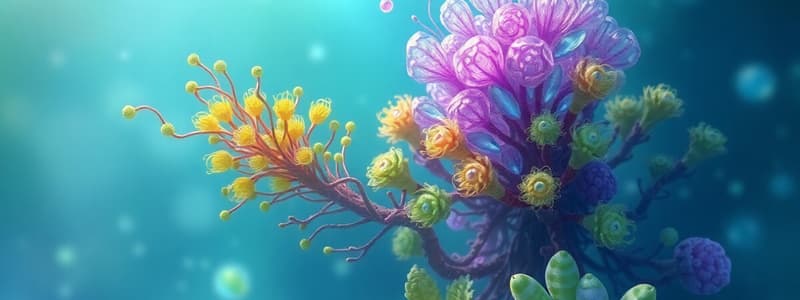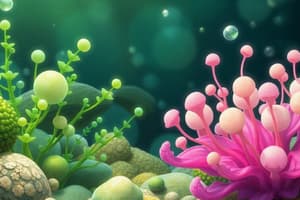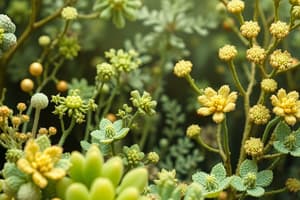Podcast
Questions and Answers
What structure do plasmodial slime molds form during unfavorable feeding conditions?
What structure do plasmodial slime molds form during unfavorable feeding conditions?
- Cell wall
- Spores (correct)
- Hyphae
- Pseudoplasmodium
Which characteristic differentiates water molds from true fungi?
Which characteristic differentiates water molds from true fungi?
- Absence of cell walls
- No chlorophyll present
- Presence of flagella on spores (correct)
- Lack of fruiting bodies
What is the primary ecological role of fungus-like protists?
What is the primary ecological role of fungus-like protists?
- Pathogens
- Primary producers
- Decomposers (correct)
- Symbiotic partners
During which phase does plasmodial slime mold exhibit a feeding mass similar to amoeba?
During which phase does plasmodial slime mold exhibit a feeding mass similar to amoeba?
Cellular slime molds form which structure when food is scarce?
Cellular slime molds form which structure when food is scarce?
What type of habitat do most dinoflagellates inhabit?
What type of habitat do most dinoflagellates inhabit?
Which type of algae is known for having glasslike cell walls containing silica?
Which type of algae is known for having glasslike cell walls containing silica?
What characteristic differentiates multicellular algae from plants?
What characteristic differentiates multicellular algae from plants?
What is a common role of brown algae in marine environments?
What is a common role of brown algae in marine environments?
Which type of algae is commonly known for forming colonies in ball-shaped structures?
Which type of algae is commonly known for forming colonies in ball-shaped structures?
Which pigment allows red algae to perform photosynthesis at great depths?
Which pigment allows red algae to perform photosynthesis at great depths?
Which group of algae includes species that can live in symbiotic relationships with fungi?
Which group of algae includes species that can live in symbiotic relationships with fungi?
What is the primary ecological role of phytoplankton?
What is the primary ecological role of phytoplankton?
What feature distinguishes diatoms from dinoflagellates?
What feature distinguishes diatoms from dinoflagellates?
Which type of algae is primarily found in warm saltwater habitats and can photosynthesize at great depths?
Which type of algae is primarily found in warm saltwater habitats and can photosynthesize at great depths?
What main characteristic differentiates unicellular algae from multicellular algae?
What main characteristic differentiates unicellular algae from multicellular algae?
How do some green algae assist in ecological relationships with fungi?
How do some green algae assist in ecological relationships with fungi?
Which of the following statements about algae is incorrect?
Which of the following statements about algae is incorrect?
What is the primary function of water molds in their ecosystem?
What is the primary function of water molds in their ecosystem?
Which characteristic distinguishes cellular slime molds from plasmodial slime molds?
Which characteristic distinguishes cellular slime molds from plasmodial slime molds?
During which stage does plasmodial slime mold become a mass of cytoplasm?
During which stage does plasmodial slime mold become a mass of cytoplasm?
Why are water molds not classified as true fungi?
Why are water molds not classified as true fungi?
What happens to plasmodial slime molds under unfavorable feeding conditions?
What happens to plasmodial slime molds under unfavorable feeding conditions?
Study Notes
Algae (plant-like)
- Perform photosynthesis and produce oxygen as a byproduct.
- Many are unicellular, but some are multicellular.
- Some are colonial, meaning they live as a group with each cell having specific functions.
Unicellular Algae
- Classified by the type of outer cover and movement.
- Dinoflagellates: Have two flagella used to spin the cell through water, covered with cellulose plates, and primarily live in saltwater habitats. Responsible for "red tides".
- Diatoms: Lack cilia and flagella, have glasslike cell walls containing silica, come in a variety of shapes and patterns, and are the most abundant organisms in the ocean. Used as abrasives in polishing agents, detergents, and toothpastes.
Multicellular Algae
- Once classified as plants due to chloroplasts and photosynthesis, but now classified as protists due to different reproductive structures from plants.
- Not necessarily microscopic.
- Green Algae: Also called Chlorophyta, mostly live in freshwater, some in the ocean, grow as filaments or flat leaf-like cells.
- Examples: Chlamydomonas (ponds and moist soil) with retractable flagella, Volvox (common colonial green algae) living in ball-shaped colonies.
- Symbiotic relationships: Some green algae live in symbiotic relationships with fungus to form lichens.
- Red Algae: Also called Rhodophyta, grow in warm saltwater habitats, not all are red (can be orange, green, brown, and black), can carry out photosynthesis at great depths due to pigments other than chlorophyll, very important for coral reefs.
- Brown Algae: Also called Phaeophyta, grow in cool saltwater habitats.
- Example: Kelp.
- Adaptations: Root-like structures for anchoring and specialized air bladders to help them float.
- Phytoplankton: Algae are a large component of plankton, specifically referred to as phytoplankton because they perform photosynthesis.
Fungus-like protists
- Divided into three groups: Plasmodial Slime Molds, Cellular Slime Molds, and Water Molds.
- Decomposers, recycling organic material into the environment.
- Extract nutrients from dead organic materials.
Plasmodial Slime Molds
- Many different colors.
- Different forms during their life cycle.
- Plasmodium: The feeding stage, forms a mass of cytoplasm similar to amoeba, feeds on bacteria and other small organisms.
- Spores: When conditions are unfavorable, the mold forms a body that produces spores. When conditions improve, the spores are released and develop into plasmodium again.
Cellular Slime Molds
- Alternate between stages similar to plasmodial slime molds, but form pseudoplasmodium ("false plasmodium") when food is scarce.
Water Molds
- Decomposers or parasites.
- Typically grow in freshwater on decaying plants and animals.
- Not true fungi because:
- Their cell walls contain cellulose instead of chitin.
- Their spores have flagella, while true fungi produce spores without flagella.
- Water Molds caused the Irish Potato Famine.
Algae
- Photosynthetic Protists
- Contain chlorophyll and produce oxygen
- Most are unicellular, but some are multicellular or colonial
- Classified by outer cover and movement
Unicellular Algae
- Dinoflagellates:
- Two flagella for movement
- Covered with cellulose plates
- Mostly live in saltwater
- Cause "red tides"
- Diatoms:
- Lack cilia and flagella
- Have glass-like cell walls with silica
- Variety of shapes and patterns
- Rigid cell walls with pores for gas exchange
- Most abundant organisms in the ocean
- Used as abrasives (polishing agents, detergents, toothpastes)
Multicellular Algae
- Were once classified as plants
- Classified as protists due to different reproductive structures from plants
- Green Algae (Chlorophyta):
- Mostly live in freshwater, some in the ocean
- Grow as filaments (linked end to end) or flat leaf-like cells
- Examples: Chlamydomonas (ponds, moist soil) - retractible flagella; Volvox (common colonial green algae) - ball-shaped colony
- Some live symbiotically with fungus (lichen)
- Red Algae (Rhodophyta):
- Grow in warm, saltwater habitats
- Various colors: red, orange, green, brown, black
- Can photosynthesize at great depths due to pigments other than chlorophyll
- Important for coral reefs
- Brown Algae (Phaeophyta):
- Grow in cool, saltwater habitats
- Example: Kelp, with root-like structures for anchoring and air bladders for floating
- Algae are a major component of plankton, specifically phytoplankton due to their photosynthetic nature
Fungus-like Protists
- Decomposers that recycle organic materials
- Extract nutrients from dead organic matter
- 3 Groups: Plasmodial Slime Molds, Cellular Slime Molds, Water Molds
Plasmodial Slime Molds
- Slimey or wet appearance
- Varying colors
- Two stages:
- Plasmodium: Feeding stage; mass of cytoplasm (like amoeba) that feeds on bacteria and small organisms
- Spore: When conditions are unfavorable, the mold stops feeding and produces spores. Spores develop into plasmodium when conditions improve.
Cellular Slime Molds
- Slimey or wet appearance
- Alternate stages like plasmodial slime molds
- Form pseudoplasmodium (false plasmodium) when food is scarce
Water Molds
- Includes white rusts and downy mildews
- Decomposers or parasites
- Typically live in freshwater on decaying plants and animals
- Not true fungi because:
- Cell walls contain cellulose (not chitin)
- Spores possess flagella (true fungal spores lack flagella)
- Caused the Irish Potato Famine
Studying That Suits You
Use AI to generate personalized quizzes and flashcards to suit your learning preferences.
Related Documents
Description
This quiz explores the fascinating world of algae, focusing on their classification as unicellular and multicellular organisms. Learn about different types of algae such as dinoflagellates and diatoms, and understand their roles in ecosystems and practical applications. Test your knowledge about their structure, reproduction, and environmental significance.




